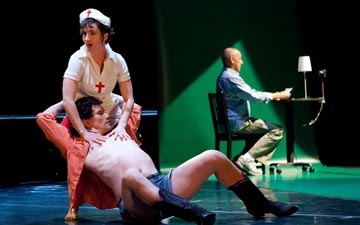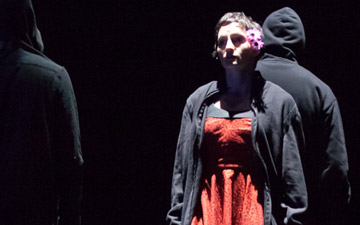
© Christopher Duggan. (Click image for larger version)
Reggie Wilson / Fist and Heel Performance Group
POWER
★★★★✰
Brooklyn/New York, Brooklyn Academy of Music
13 Jan 2022
www.fistandheelperformancegroup.org
bam.org
The lights faintly dawn as lanky, dreadlocked Reggie Wilson walks onstage. He is vocalizing under his breath the Shaker hymn “Simple Gifts” as he carefully gathers up a colorful, batik garment lying in his path and cradles it moving it to a new location. He transfers other remaining pieces of apparel – his singing growing louder, he belts out the line, “’Tis the gift to be free.” Wilson exits as the nine members of Fist and Heel enter from his point of departure, trailed by Wilson, who sits down on a bench at the downstage corner to the audience’s left. From there he accompanies and energizes the dancers with vocalizing, foot-tapping, clapping, and gourd rattle shaking to the recorded music compilation throughout the performance.
Welcome to POWER – a work borne of reimagining what Black Shaker worship was like in all its amazing complexity. The piece was inspired by Wilson’s enduring curiosity about the Shakers and his discovery of Mother Rebecca Cox Jackson, a black woman spiritual leader and founder of her own Shaker community in Philadelphia. Shaker life and worship have long sparked the creative imagination of choreographers – Doris Humphrey’s 1931 The Shakers, Tero Saarinen’s 2004 Borrowed Light, Martha Clarke’s 2011 Angel Reapers, and now POWER. How could it not speak to dancers? This utopian spiritual society gave physical movement primacy over words – something that dancers inherently know and live. In fact, the Shakers believed that all faculties should be used in worship and considered the body as a vessel for receiving divine spirit. Shaker dances were a complete and direct form of worship as well as a didactic tool for teaching the theology – as many original Shakers were illiterate. Additionally, the Shakers’ use of choreographed group formations, with interweaving patterns and shifting relationships, was employed to inculcate an attitude of harmony and cohesion within community.

© Tony Turner. (Click image for larger version)
Wilson’s interest increased with the added discovery that in the mid-1800s there was a free black woman, Mother Rebecca Cox Jackson, who felt the call and inner power to preach her own practices and theology. She eventually joined a Shaker establishment and later formed her own religious community. Wilson wondered what black Shaker worship might look like. Early in the project, he visited Shaker villages and the company studied Shaker movements from a video of reconstructed dances produced by the Enfield Shaker Singers. Added to that, Wilson’s work regularly draws on his research into the spiritual and mundane traditions of Africa and its diaspora. Thus, with the knowledge of these traditions, POWER was created.
Upon arriving onstage, the dancers, wearing simple, dark, practice attire, busy themselves getting dressed in the colorful print costumes lying about. Three women now dressed in full skirts form a circle and perform a postmodern movement phrase that will be reprised throughout the work. In this visually memorable motif, the women extend a leg out to the side and then let it drop to the floor (with a thud) as their gaze and an arm reach upward. The arm, gaze, and body melt downward as the women descend into a deep plié. They brush one leg off the floor and, holding the position, perform a series of hopping turns.

© Christopher Duggan. (Click image for larger version)
The men, now clad in white muslin overalls, bring decorative collars for the women to add to their costumes and join them in a square formation. With this, Wilson introduces his re-imagined Black Shaker dance. Using Shaker gestures – arms bent with palms lifted to receive blessings and shaking palms downward to shake out impurity – they dance crisscrossing patterns as they sing and clap. Initially, they carry themselves in an upright (white) posture – but this gradually changes.
In this and subsequent tableaux, the Shaker movement motif is repeated with different costuming, groupings, floor patterns, and most importantly – with different music. Wilson superimposes a musical global-fest of gospel, spirituals, soul, blues, fife and drum, shout, and other African and Africanist traditions onto his Shaker dance (as well as the postmodern dance). As Wilson’s infectious, live vocalizations and syncopated clapping and percussion take off, the rhythms infiltrate the dance with a new energy. The shuffling steps and jumps become more weighted and earthy. Simple overhead arm circles grow freely tossed. Rib cages rotate, shoulders pulsate, hips vibrate, and torsos undulate as the undercurrent of African rhythmic movement insinuates itself into the dancers’ bodies until the simple Shaker movements are utterly transformed. Wilson conjures magic with his layering of enthralling music and engaging group formations – moving from a single line to parallel lines to a square to circles (single, concentric, and side-by-side) – all flowing into a transcendent expression.

© Tony Turner. (Click image for larger version)
Throughout the work, scenes marked by the postmodern style alternate with those displaying the Black Shaker concept. With the overlay of varied music traditions and percussion and variation of groupings and spatial patterns, the two dance forms seem to lose their separate characteristics and merge as a spiritual expression. At times, veteran dancer Lawrence Harding ceremoniously walks the perimeter of the dance space like a guardian protector of the sacred ground and those not dancing frequently gather alongside Wilson and join in the vocalizations and clapping. Every scene is saturated with hybridity and builds to a vibe of embodied worship. The notable lighting design by Jonathan Belcher augments the mood by integrating light-muting screens to simulate the subtle aesthetic of “borrowed light” used in Shaker architecture to draw natural light (and the Divine) into the dark.
My only complaint is that there was no discernible thread connecting the piece as a whole. Without a connecting narrative or the dramatic arc of a recreated ritual, each scene feels like a separate dance number. And no matter what fevered pitch the previous sequence achieves, the momentum is lost as each new scene begins quietly with a costume change and develops to a similar pitch using similar methods. Nonetheless, the work is fascinating and was well-received by the audience.
In the performance playbill, Reggie Wilson states, “POWER is dedicated to The Dead.” A dedication is a form of offering or acknowledgement. In spiritual traditions, one generally includes offerings to the ancestors in acknowledgement of their foundation of wisdom that supports and nourishes the present journey. Given that POWER draws its very existence and vibrancy from an ancestral legacy of traditions and practices (both imagined and historical) and given that dance in some cultures is considered a ritual offering, this dedication is a most fitting, simple gift.

















You must be logged in to post a comment.